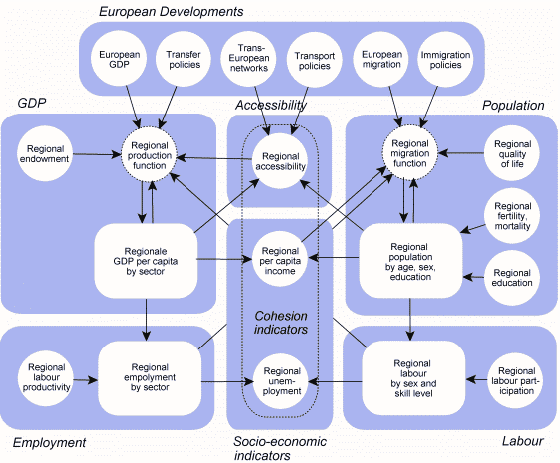 The regional economic model SASI was developed at the Institute of Spatial Planning of the University of
Dortmund since 1996 in co-operation with the Technical University of Vienna in the EU project SASI (Spatial and
Socio-economic Impacts of Transport Investments and Transport System Improvements). The model has
since been applied in several EU projects, such as IASON (Integrated Appraisal of Spatial Economic
and Network Effects of Transport Investments and Policies), ESPON 2.1.1
(Territorial Impacts of EU Transport and TEN Policy) of the European Spatial Planning Observation Network
(ESPON), the Interreg-IIIb project AlpenCorS (Alpen Corridor South)
and the projects STEPs (Scenarios for the Transport System and Energy Supply
and their Potential Effects) and ESPON ET2050 (Territorial Scenarios
and Visions for Europe).
The regional economic model SASI was developed at the Institute of Spatial Planning of the University of
Dortmund since 1996 in co-operation with the Technical University of Vienna in the EU project SASI (Spatial and
Socio-economic Impacts of Transport Investments and Transport System Improvements). The model has
since been applied in several EU projects, such as IASON (Integrated Appraisal of Spatial Economic
and Network Effects of Transport Investments and Policies), ESPON 2.1.1
(Territorial Impacts of EU Transport and TEN Policy) of the European Spatial Planning Observation Network
(ESPON), the Interreg-IIIb project AlpenCorS (Alpen Corridor South)
and the projects STEPs (Scenarios for the Transport System and Energy Supply
and their Potential Effects) and ESPON ET2050 (Territorial Scenarios
and Visions for Europe).

The SASI model
The SASI model has been continuously further developed in the course of the projects. Most recent developments include the modelling of generative effects of transport infrastructure investments and the inclusion of the West Balkan countries into the study area. The present state of the model is described in
Wegener, M. (2008): SASI Model Description. Working Paper 08/01. Dortmund: Spiekermann & Wegener Urban and Regional Research.
Descriptions of the model according to the state of its development at the time of writing are contained in
Spiekermann, K., Wegener, M. (2014): Integrated Spatial Scenarios until 2050. ET2050 Scientific Report Volume 6. Dortmund: Spiekermann & Wegener Stadt- und Regionalforschung.
Spiekermann, K., Wegener, M. (2013): Regional Impacts of a Railway Tunnel between Helsinki and Tallinn. Final Report of the project " "H-TTransPlan – Helsinki-Tallinn Transport and Planning Scenarios". Dortmund: Spiekermann & Wegener Urban and Regional Research.
ECORYS Nederland BV (2007): Ex-ante Evaluation of the TEN-T Multi-Annual Programme 2007-2013. Final Report. Rotterdam: ECORYS Nederland BV.
ECORYS Nederland BV (2006): Strategic Evaluation on Transport Investment Priorities under Structural and Cohesion Funds for the Programming Period 2007-2013. Synthesis Report for the European Commission, DG Regio. Rotterdam: ECORYS Nederland BV.
Spiekermann, K., Wegener, M. (2005): Raumstrukturelle Auswirkungen einer Internalisierung externer Kosten des Verkehrs in Sachsen. Teilstudie im Rahmen des Projekts "Auswirkungen einer Internalisierung externer Kosten des Verkehrs in Sachsen". Dortmund: Spiekermann & Wegener Urban and Regional Research.
Spiekermann, K., Wegener, M. (2005): Modelling Regional Development in AlpenCorS: Scenario Results. Final Report for AlpenCorS. Dortmund: Spiekermann & Wegener Urban and Regional Research.
Bröcker, J., Capello, R., Lundqvist, L., Meyer, R., Rouwendal, J., Schneekloth, N., Spairani, A., Spangenberg, M., Spiekermann, K., van Vuuren, D., Vickerman, R. Wegener, M. (2005): Territorial Impacts of EU Transport and TEN Policies. Final Report of ESPON 2.1.1. Kiel: Christian Albrechts University of Kiel.
Bröcker, J., Meyer, R., Schneekloth, N., Schürmann, C., Spiekermann, K., Wegener, M. (2004): Modelling the Socio-Economic and Spatial Impacts of EU Transport Policy. Deliverable D6 of IASON (Integrated Appraisal of Spatial Economic and Network Effects of Transport Investments and Policies). Kiel/Dortmund: Christian Albrechts University of Kiel.
Wegener, M., Bökemann, D. (1998): The SASI Model: Model Structure. Berichte aus dem Institut für Raumplanung 40. Dortmund: Institute of Spatial Planning, University of Dortmund.
